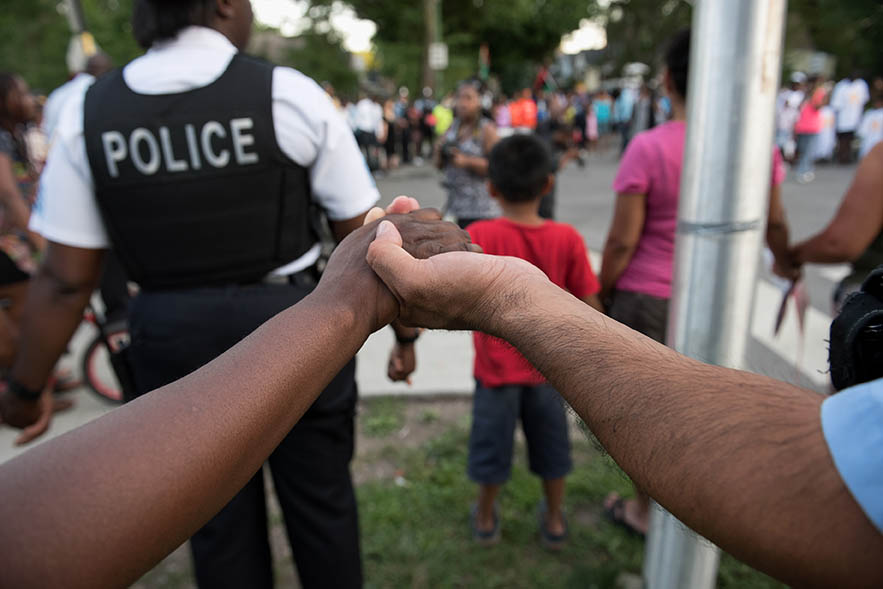Public Safety and Violence Prevention

After seeing the fewest murders in Chicago in 2014 since 1965, the city endured a traumatic and unprecedented rise in gun violence in 2016. That September, Mayor Emanuel called on all Chicagoans to join in a comprehensive plan to confront gun violence that included: strengthening law enforcement resources; increased investments in violence prevention; advocacy for legislation to address gun violence; deepened economic development and employment opportunities to treat the root causes of violence; and community trust and legitimacy between the Chicago Police Department (CPD) and the communities it officers serve.
Since that call to action by Mayor Emanuel, CPD has added more officers, increased the numbers of sergeants, field training officers, and detectives, substantially increased training, reformed oversight, and introduced state of the art technology to fight gun violence. Though much work still needs to be done, the strategy has led to marked decline from the peak of violence in 2016.
-
In late 2016, Mayor Emanuel announced a two-year hiring plan that would add nearly 1,000 new sworn positions to the force, in addition to filling current vacancies created by attrition or promotion across all ranks. To date, nearly 2,400 new officers have entered the training academy and more than 1,200 officers have been promoted.
-
In October 2016, the City Council passed an ordinance that created the Civilian Office of Police Accountability (COPA) and the Public Safety Deputy Inspector General—two new critical functions proposed by Mayor Emanuel to strengthen police accountability and transparency. COPA has the authority to investigate incidents of police misconduct, use of force, and officer-involved shooting incidents. The Public Safety Deputy Inspector General monitors the entire police discipline system, detecting potential patterns of abuse and ensuring transparency.
-
For the first time in Chicago Police Department history, an in-service training program began in 2018 requiring sworn members to complete a set of training hours on an annual basis on topics like implicit bias, procedural justice, mental health, cultural competency, and community policing.
-
In 2017, CPD took important steps to improve its crisis response during mental health emergencies through its Crisis Intervention Team (CIT). Improvements to the program included revisions to the 40-hour training curriculum an expanded cadre of civilian CIT instructors.
-
In 2015, CPD launched a body worn camera pilot in a single district which later expanded to six more districts in 2016. By the end of 2017, more than 7,000 sworn CPD personnel, including all district-assigned CPD officers, tactical officers and supervisors, were equipped with body worn cameras. The roll-out was completed a full year ahead of schedule.
-
Mayor Emanuel and the Chicago Police Department instituted a smart policing strategy that leverages data and technology to address crime in police districts across the City through the creation of Strategic Decision Support Centers (SDSC). The strategy has included the installation of gunshot detection systems and high definition cameras that provide critical information for better, more timely resource deployment. Through the Mayor’s leadership, the City established SDSCs in 20 of the 22 police districts across the city. These investments have contributed to more than two years of consecutive declines in violent crimes.
-
The Safe Passage Program was launched in 2012 to reduce crime and keep students safe during their commutes to and from school. The program has thrived by using a community-based model, employing workers who live in the communities they serve. More than 150 schools are part of the program, employing 1,350 Safe Passage workers and serving nearly 80,000 Chicago Public Schools students. The program resulted in a 9 percent reduction in crime on Safe Passage routes since the 2016-2017 school year.
-
The Mayor created the Office of Violence Prevention within the Mayor’s Office in the 2019 budget to further align strategies and investments for violence prevention and intervention across city departments and identify new investments in services and strategies that target individuals who are at elevated risk of violence involvement.
Read more about the Public Safety and Violence Prevention progress made over the last eight years.
